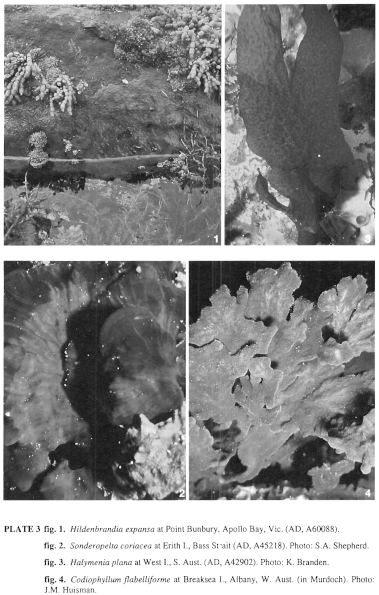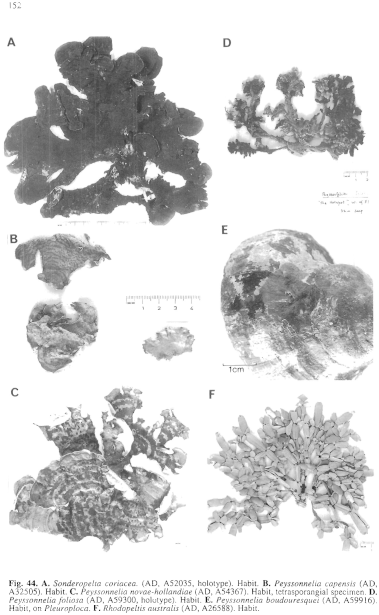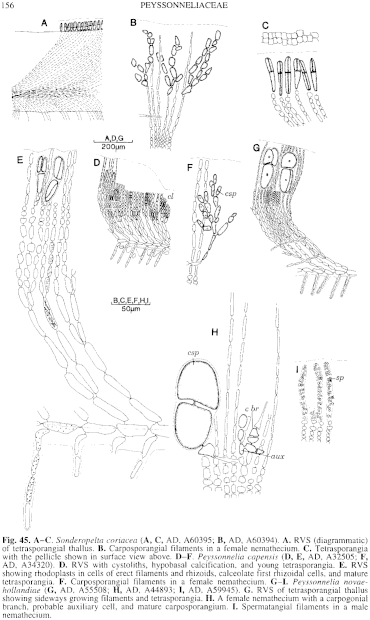|
|
|
|
|
|||||||||||
|
Electronic Flora of South Australia Species Fact Sheet
Phylum Rhodophyta – Class Florideophyceae – Order Gigartinales – Family Peyssonneliaceae
Synonyms
Ethelia australis (Sonder) Weber-van Bosse 1921: 300, excl. type.
Sonderophycus australis (Sonder) Denizot 1968: 260, 307, figs 224–227, excl. type. [non Peyssonnelia australis Sonder 1853: 685 (=P. capensis Montagne).]
Thallus (Fig. 44A) eccentrically peltate, spreading from a short (0.5–2 cm long and 0.5–1.5 cm broad) fibrous stipe of interwoven multicellular rhizoids, with the lamina usually separated from the substratum by 0.5–2 cm. Lamina simple to lobed and often becoming split, 5–20 (–25) cm long and 5–15 cm broad, cartilaginous, 0.5–1 (–1.5) mm thick, with concentric growth zones and often slight ridges, margin smooth and relatively thick. Structure (Fig. 45A). Growth of thallus marginal, with the assurgent filaments extending apically; rhizoids produced terminally from the lower assurgent filaments, multicellular, 8–12 µm in diameter, cells L/D 3–6, not or only weakly adherent to the substrate. Assurgent filaments (Fig. 45A) spreading to both surfaces from a broad common region of longitudinal filaments, the upper filaments distinctly longer, 3–6 (–8) µm in diameter with cells L/D 4–8, shorter above, with occasional sideways growing filaments present; uppermost erect filaments 60–100 µm and 6–12 cells long, 5–8 µm in diameter, cells L/D 0.5–1.5. Rhodoplasts discoid, forming a reticulum in larger cells.
Reproduction: Reproduction rarely observed, the nemathecia being caducous leaving virtually no remnants on the surface. The only known fertile collections are from Point Lonsdale, Vic., and from Long Gully, S of Robe, S. Aust. Carposporangial nemathecia irregularly covering thallus, raised and with defined edges, 200–350 µm thick, carposporangia in branched chains (Fig. 45B), ovoid to angular, 7–10 µm in diameter. Spermatangia unknown.
Tetrasporangial nemathecia (Fig. 45C) shallow, irregularly covering extensive areas of thalli, without paraphyses, tetrasporangia 40–60 µm long, 10–12 µm in diameter, cruciately divided; pellicle (Fig. 45C) of nemathecium firm, showing wall pattern of sporangia.
Type from Pondalowie Bay, S. Aust., 2–3 m deep in heavy shade (Clarke, 14.ii.1981; holotype in AD, A52035 - isotypes in "Marine Algae of southern Australia" No. 214).
Selected specimens: D'Entrecasteaux Reef, Head of Great Australian Bight, S. Aust., 15–20 m deep (Shepherd, 27.iii.1980; AD, A52155). Masillon I., Isles of St Francis, S. Aust., 22 m deep (Shepherd, 5.i.1971; AD, A37890). Hopkins I„ S. Aust., 33 m deep (Branden, 8.i.1989; AD, A59997). Amphitheatre Rock, West I., S. Aust., 13 m deep (Shepherd, 1.i.1969; AD, A33252). Long Gully, S of Robe, S. Aust., drift (0' Leary, 18.viii.1991; AD, A61477, tetrasporangial). Nora Creina, S. Aust., 12 m deep (Mitchell, 26.v.1963; AD, A26500). Cape Northumberland, S. Aust., 2–3 m deep (Edyvane, 5.vi.1982; AD, A55504). Portland, Vic., 8–11 m deep, N side Lawrence Rock (Larkum, 2.ix.1971; AD, A39629). Point Lonsdale, Vic., 3–4 m deep at base of Lighthouse Reef (Kraft & La Feria, 31.v.1990; MELU, A38213, (AD, A60395), tetrasporangial, and MELU, A38214 (AD, A60394), female. Walkerville, Vic., drift (Sinkora A2120, 1.iii.1975; AD, A48401). West Point, Erith I., Bass Strait, 15 m deep (Shepherd & R. Lewis, 7.v.1974; AD, A45218). Stapleton Point, Prosser Bay, Tas., 10 m deep (Olsen, 28.vii.1966; AD, A30636). Lady Bay, Southport, Tas., 3–5 m deep (Brown & Womersley, 28.x.1982; AD, A56502).
Distribution: Three Kings Islands, New Zealand (Adams & Nelson 1985, p. 18). D'Entrecasteaux Reef, S. Aust., to Walkerville, Vic., and the east coast of Tasmania, in 1–25 m depths.
Taxonomic notes: Sonderopelta coriacea is a distinctive alga, often abundant in shaded overhangs and caverns or in deeper water. The collections of fertile plants show that while Sonderopelta belongs to the Peyssonneliaceae, it differs from other genera in lacking sterile paraphyses in the tetrasporangial nemathecia.
References:
ADAMS, N.M. & NELSON, W.A. (1985). The marine algae of the Three Kings Islands. A list of species. Nat. Mus. N.Z., Misc. Ser. No. 13, pp. 1–29.
DENIZOT, M. (1968). Les Algues Floridées encroûtantes (a l'exclusion des Corallinacées). (Paris.)
SONDER, O.W. (1853). Plantae Muellerianae. Algae. Linnaea 25, 657–709.
WEBER-VAN BOSSE, A. (1921). Liste des Algues du Siboga. II. Rhodophyceae. Part I. Protoflorideae, Némalionales, Cryptonemiales. Siboga-Expeditae, Monogr. Lab, pp. 187–310, Plates 6–8.
WOMERSLEY, H.B.S. & SINKORA, D. (1981). Sonderophycus and the type specimen of Peyssonnelia australis (Cryptonemiales, Rhodophyta). Trans. R. Soc. S. Aust. 105, 85–87.
The Marine Benthic Flora of Southern Australia Part IIIA complete list of references.
Publication:
Womersley, H.B.S. (14 January, 1994)
The Marine Benthic Flora of Southern Australia
Rhodophyta. Part IIIA, Bangiophyceae and Florideophyceae (to Gigartinales)
Reproduced with permission from The Marine Benthic Flora of Southern Australia Part IIIA 1994, by H.B.S. Womersley. Australian Biological Resources Study, Canberra. Copyright Commonwealth of Australia.
Illustrations in Womersley Part IIIA, 1994: PLATE 3 fig. 2; FIGS 44A, 45 A–C.

Plate 3 enlarge
PLATE 3 fig. 1. Hildenbrandia expansa at Point Bunbury, Apollo Bay, Vic. (AD, A60088). fig. 2. Sonderopelta coriacea at Erith I., Bass Strait (AD, A45218). Photo: S.A. Shepherd. fig. 3. Halymenia plana at West I., S. Aust. (AD, A42902). Photo: K. Branden. fig. 4. Codiophyllum flabelliforme at Breaksea I., Albany, W. Aust. (in Murdoch). Photo: J.M. Huisman.

Figure 44 enlarge
Fig. 44. A. Sonderopelta coriacea. (AD, A52035, holotype). Habit. B. Peyssonnelia capensis (AD, A32505). Habit. C. Peyssonnelia novae-hollandiae (AD, A54367). Habit, tetrasporangial specimen. D. Peyssonnelia foliosa (AD, A59300, holotype). Habit. E. Peyssonnelia boudouresquei (AD, A59916). Habit, on Pleuroploca. F. Rhodopeltis australis (AD, A26588). Habit.

Figure 45 enlarge
Fig. 45. A–C. Sonderopelta coriacea (A, C, AD, A60395; B, AD, A60394). A. RVS (diagrammatic) of tetrasporangial thallus. B. Carposporangial filaments in a female nemathecium. C. Tetrasporangia with the pellicle shown in surface view above. D–F. Peyssonnelia capensis (D, E, AD, A32505; F, AD, A34320). D. RVS with cystoliths, hypobasal calcification, and young tetrasporangia. E. RVS showing rhodoplasts in cells of erect filaments and rhizoids, calceolate first rhizoidal cells, and mature tetrasporangia. F. Carposporangial filaments in a female nemathecium. G–I. Peyssonnelia novae hollandiae (G, AD, A55508; H, AD, A44893; I, AD, A59945). G. RVS of tetrasporangial thallus showing sideways growing filaments and tetrasporangia. H. A female nemathecium with a carpogonial branch, probable auxiliary cell, and mature carposporangium. I. Spermatangial filaments in a male nemathecium.

|
Email Contact: State Herbarium of South Australia |

|